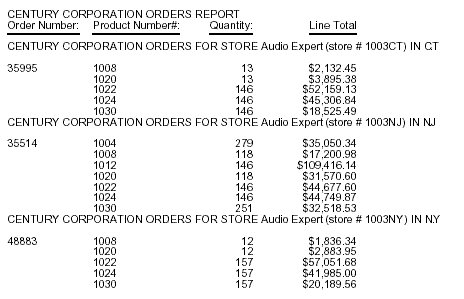Positioning Headings, Footings, or Items Within Them
For a PDF, PS, or HTML report, you can use the POSITION attribute in a StyleSheet to specify a starting position for a heading or footing, expressed as a unit measurement. For HTML, this capability requires an internal cascading style sheet. For details on selecting an alignment method, see Choosing an Alignment Method for Heading and Footing Elements.
In addition, for a PDF or PS report, you can use the POSITION attribute to specify an absolute or relative starting position for an element within a heading or footing or to align an item in a heading or footing with a report column. An absolute starting position is the distance from the left margin of the report. A relative starting position is the distance from the preceding object. For the first item on a heading line this is the left margin of the report.
In an HTML report, you can use related syntax and an internal cascading style sheet to position an image in a heading or footing. For details on images, see Laying Out the Report Page.
Set a Starting Position for a Heading or Footing
Use the following syntax to specify a starting position for an entire heading or footing in relation to the left margin of a report.
TYPE = headfoot, POSITION = position, $
where:
Setting a Starting Position for a Report Heading in PDF
This request positions the report heading 1.25 inches from the left margin.
SET ONLINE-FMT=PDF TABLE FILE GGSALES PRINT BUDDOLLARS DOLLARS BY STCD WHERE BUDDOLLARS GE 25000 WHERE STCD EQ 'R1019' ON TABLE SUBHEAD "Sales Report" " " ON TABLE SET PAGE-NUM OFF ON TABLE SET SQUEEZE ON ON TABLE SET STYLESHEET * TYPE = TABHEADING, POSITION = 1.25, $ ENDSTYLE END
The output is:
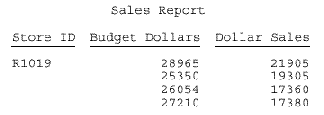
Setting a Starting Position for a Report Heading in HTML
The request generates an internal cascading style sheet as part of its HTML code, enabling the use of the POSITION attribute to specify a starting position for the heading, Sales Report, 1.5 inches from the left margin.
SET ONLINE-FMT = HTML TABLE FILE GGSALES PRINT BUDDOLLARS DOLLARS BY STCD WHERE BUDDOLLARS GE 25000 WHERE STCD EQ 'R1019' ON TABLE SUBHEAD "Sales Report" " " ON TABLE SET PAGE-NUM OFF ON TABLE SET HTMLCSS ON ON TABLE SET STYLESHEET * TYPE=REPORT, GRID=OFF, $ TYPE = TABHEADING, POSITION = 1.5, $ ENDSTYLE END
The output is:
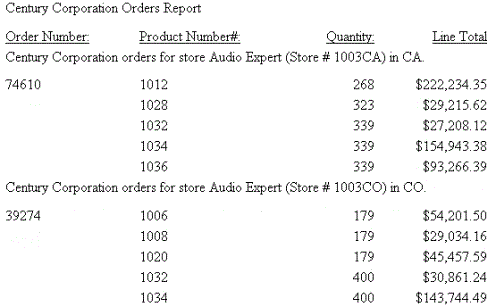
Set a Starting Position for a Heading or Footing Element
For a PDF or PS report, use the following syntax to specify a starting position for a heading or footing element in relation to the preceding item
TYPE = headfoot, [subtype,] POSITION = {+|-}option, $
where:
Is the type of heading or footing. Valid values are TABHEADING, TABFOOTING, HEADING, FOOTING, SUBHEAD, and SUBFOOT.
Are additional attributes that identify the report component. These options can be used separately or in combination, depending upon the degree of specificity you need to fully identify an element. Valid values are:
- LINE, which
identifies a line by its position in a heading or footing. Identifying
individual lines enables you to format each line differently.
If a heading or footing has multiple lines and you apply a StyleSheet declaration that does not specify LINE, the declaration is applied to all lines. Blank lines are counted when interpreting the value of LINE.
- ITEM, which
identifies an item by its position in a line. To divide a heading
or footing line into items, you can use the <+0> spot marker.
For details, see Identifying a Report Component in an ibi WebFOCUS StyleSheet.
To determine an ITEM number for an OBJECT, follow these guidelines:
- When used with OBJECT=TEXT, count only the text strings from left to right.
- When used with OBJECT=FIELD, count only values from left to right.
- When used without OBJECT, count text strings and field values from left to right.
If you apply a StyleSheet declaration that specifies ITEM, the number is counted from the beginning of each line in the heading or footing, not just from the beginning of the first line.
- OBJECT, which
identifies an element in a heading or footing as a text string or
field value. Valid values are TEXT or FIELD. TEXT may represent
free text or a Dialogue Manager amper (&) variable.
It is not necessary to specify OBJECT=TEXT unless you are styling both text strings and embedded fields in the same heading or footing.
Is the alignment method. Valid values are:
- position, which is the desired distance, expressed by the UNITS attribute (the default is inches) for absolute positioning.
- +, which starts the heading or footing element at the specified distance to the right of the preceding item. For the first item in a heading or footing, the preceding item is the left margin of the report.
- -, which starts the heading or footing element at the specified distance to the left of the preceding item. This is useful if you want to overlap images in a heading.
- column_title, which aligns the heading or footing element with the first character of the designated column.
Setting an Absolute Starting Position for a Heading Item
This request uses the spot marker <+0> to divide the report heading into three text strings. It starts the third text string, 1st Qtr 2001, 3 inches from the left report margin. This technique can be used in PDF as well as PS reports.
SET ONLINE-FMT = PDF TABLE FILE GGSALES SUM UNITS DOLLARS BY CATEGORY BY PRODUCT ON TABLE SUBHEAD "Sales Report - <+0>All Products<+0> 1st Qtr 2001" " " ON TABLE SET PAGE-NUM OFF ON TABLE SET SQUEEZE ON ON TABLE SET STYLESHEET * TYPE = TABHEADING, OBJECT = TEXT, ITEM=1, SIZE = 12, STYLE = BOLD, $ TYPE = TABHEADING, OBJECT = TEXT, ITEM=2, STYLE = BOLD, $ TYPE = TABHEADING, OBJECT = TEXT, ITEM=3, POSITION = 3, $ ENDSTYLE END
The output is:
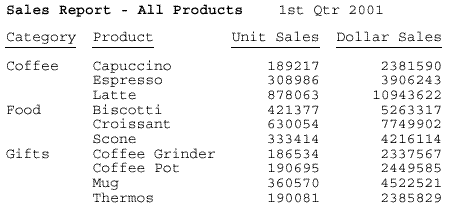
Setting a Relative Starting Position for a Heading Item
This request uses the spot marker <+0> to divide the report heading into three text strings. It starts the third text string, 1st Qtr 2001, one inch to the right of the previous item on the heading line. Inches is the default unit of measure. This technique can be used in PDF as well as PS reports.
SET ONLINE-FMT = PDF TABLE FILE GGSALES SUM UNITS DOLLARS BY CATEGORY BY PRODUCT ON TABLE SUBHEAD "Sales Report - <+0>All Products<+0> 1st Qtr 2001" " " ON TABLE SET PAGE-NUM OFF ON TABLE SET SQUEEZE ON ON TABLE SET STYLESHEET * TYPE = TABHEADING, OBJECT = TEXT, ITEM=1, SIZE = 12, STYLE = BOLD, $ TYPE = TABHEADING, OBJECT = TEXT, ITEM=2, STYLE = BOLD, $ TYPE = TABHEADING, OBJECT = TEXT, ITEM=3, POSITION = +1, $ ENDSTYLE END
The output is:
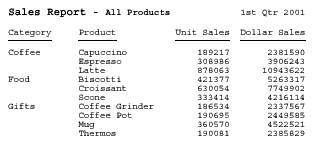
Aligning a Heading Item With a Column
This request uses the spot marker <+0> to divide the report heading into three text strings. It starts the second text string at the horizontal position where the column UNITS (Unit Sales) is. This technique can be used in PDF as well as PS reports.
SET ONLINE-FMT = PDF TABLE FILE GGSALES SUM UNITS DOLLARS BY CATEGORY BY PRODUCT ON TABLE SUBHEAD "Sales Report - <+0>All Products<+0> 1st Qtr 2001" " " ON TABLE SET PAGE-NUM OFF ON TABLE SET SQUEEZE ON ON TABLE SET STYLESHEET * TYPE = TABHEADING, LINE=1, ITEM=2, POSITION=UNITS, $ ENDSTYLE END
The output is:
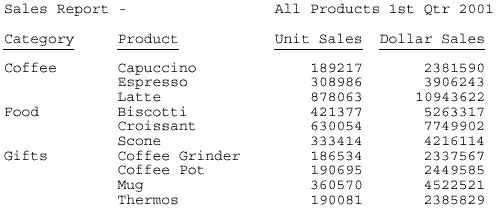
Using PRINTPLUS
PRINTPLUS includes enhancements to display alternatives offered by WebFOCUS. For example, you can place a FOOTING after a SUBFOOT in your report. PRINTPLUS provides the flexibility to produce the exact report you desire.
The PRINTPLUS parameter must be set to ON to use the following TABLE capabilities:
- PAGE-BREAK is handled internally to provide the correct spacing of pages. For example, if a new report page is started and an instruction to skip a line at the top of the new page is encountered, WebFOCUS knows to suppress the blank line and start at the top of the page.
- NOSPLIT is handled internally. (Use NOSPLIT to force a break at a specific spot.)
- You can perform RECAPs in cases where pre-specified conditions are met.
- A Report SUBFOOT now prints above the footing instead of below it.
- Data displays correctly in subfoots when IF/WHERE TOTAL or BY HIGHEST is used.
- BY field actions are linked with BY field options so they appear on the same page. The footing no longer splits on two pages.
- Footings and Subfoots always appear on a page with at least one data item, and will never split between two pages.
- Printing beyond the length of the page no longer occurs.
- Splitting of fields linked by OVER onto separate pages no longer occurs.
- There is no reserved space for conditional output. The output page is fully used.
- The order of sort fields is no longer relevant.
Use PRINTPLUS
Issue the command
SET PRINTPLUS = {ON|OFF}
Using PRINTPLUS With SUBFOOT and FOOTING
With PRINTPLUS on, the SUBFOOT prints first, followed by the FOOTING.
SET PRINTPLUS = ON TABLE FILE CAR PRINT CAR MODEL BY SEATS BY COUNTRY IF COUNTRY EQ ENGLAND OR FRANCE OR ITALY ON TABLE SUBFOOT " " " SUMMARY OF CARS IN COUNTRY BY SEATING CAPACITY" FOOTING " RELPMEK CAR SURVEY " ON TABLE SET STYLE * TYPE=REPORT,GRID=OFF,$ ENDSTYLE END
The output is:
SEATS |
COUNTRY |
CAR |
MODEL |
----- |
------- |
— |
----- |
2 |
ENGLAND |
TRIUMPH |
TR7 |
ITALY |
ALFA ROMEO |
2000 GT VELOCE |
|
ALFA ROMEO |
2000 SPIDER VELOCE |
||
MASERATI |
DORA 2 DOOR |
||
4 |
ENGLAND |
JAGUAR |
V12XKE AUTO |
JENSEN |
INTERCEPTOR III |
||
ITALY |
ALFA ROMEO |
2000 4 DOOR BERLINA |
|
5 |
ENGLAND |
JAGUAR |
XJ12L AUTO |
FRANCE |
PEUGEOT |
504 4 DOOR |
|
SUMMARY OF CARS IN COUNTRY BY SEATING CAPACITY |
|||
RELPMEK CAR SURVEY |
|||
Using Spot Markers to Refine Positioning
You can employ several types of spot markers to refine the positioning of headings and footings, and elements within them, in HTML and PDF reports that use proportional fonts. For maximum control, you can combine spot markers with other alignment techniques. See Choosing an Alignment Method for Heading and Footing Elements.
The following spot markers enable you to position items and to identify items to be formatted:
- <+0> divides
a heading or footing into items for formatting.
To divide a heading or footing into items that can be formatted separately, place the <+0> spot marker after the text string or field you wish to specify. It will not add any additional spaces to your heading or footing. For details, see Identifying a Report Component in an ibi WebFOCUS StyleSheet.
- </n specifies skipped
lines.
To specify skipped lines in a heading or footing, place the </n> spot marker on the same line as the text in the request. If you place it on a line by itself, WebFOCUS counts the line the spot marker is on plus the number of skip-lines you designate. For details, see Controlling the Vertical Positioning of a Heading or Footing.
- <-n controls the positioning of a character immediately following a field.
You can also use spot markers to position heading and footing elements at fixed and relative column locations. Several spot markers control positioning based on the pre-defined width of a character in a monospace font. This is a legacy formatting technique that is not supported for proportional fonts.
Positioning a Character Immediately After a Field in an HTML Report
This request generates an HTML report in which the closing parenthesis and the period in the sort heading follow immediately after the STORE_CODE and STATE fields, respectively. This behavior is controlled by the <-1 spot markers, which indicate a relative starting position from the preceding object. Without these spot markers to indicate that the punctuation characters should follow the preceding objects, an extra space would appear in each of these positions in the display.
SET ONLINE-FMT = HTML SET PAGE-NUM = OFF JOIN STORE_CODE IN CENTCOMP TO STORE_CODE IN CENTORD
TABLE FILE CENTCOMP HEADING "Century Corporation Orders Report </1" PRINT PROD_NUM QUANTITY LINEPRICE BY STORE_CODE NOPRINT BY ORDER_NUM ON STORE_CODE SUBHEAD "Century Corporation orders for store <STORENAME <0X (store # <STORE_CODE<-1 ) in <STATE|.</1" ON TABLE SET STYLE * TYPE=REPORT, GRID=OFF, $ ENDSTYLE END
The partial output is:

Positioning a Character Immediately After a Field in a PDF or PS Report
In a PDF report, an embedded field in a heading or footing must be followed by a space in the request to be recognized for processing. However, in the output the space may not be desirable. This example demonstrates two techniques for positioning punctuation characters immediately after a field in a PDF report.
The first technique uses the POSITION attribute in a StyleSheet to position the closing parenthesis immediately after the STORE_CODE value. The second technique uses the <-1 spot marker to position the period immediately after the STATE value. The POSITION measurement is based on the UNITS designation POINTS. Experimentation demonstrated that -7 points moves the closing parenthesis to the proper location after the field, using the default proportional font and size.
SET ONLINE-FMT = PDF SET PAGE-NUM = OFF JOIN STORE_CODE IN CENTCOMP TO STORE_CODE IN CENTORD TABLE FILE CENTCOMP HEADING "Century Corporation Orders Report" PRINT PROD_NUM QUANTITY LINEPRICE BY STORE_CODE NOPRINT BY ORDER_NUM ON STORE_CODE SUBHEAD "Century Corporation orders for store <STORENAME (store # <STORE_CODE ) in <0X <STATE <-1 . </1" ON TABLE SET STYLE * TYPE=REPORT, GRID=OFF, UNITS=POINTS, $ TYPE=SUBHEAD, OBJECT=TEXT, ITEM=3, POSITION= -7, $ ENDSTYLE END
The output is:
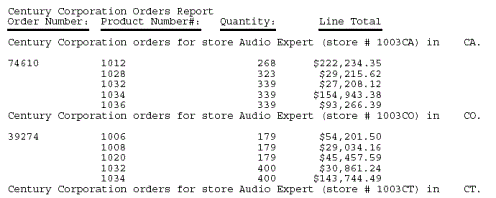
Without the spot marker and position measurement, the output would have looked like this:
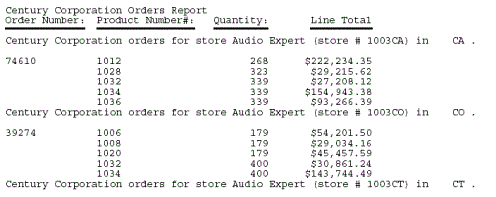
Customizing Position Measurements for Font Attributes
This request uses a 12-point Helvetica font. Experimentation demonstrated that the POSITION value of -2 moves the text in this font and size to the required position.
SET ONLINE-FMT = PDF
SET PAGE-NUM = OFF
JOIN STORE_CODE IN CENTCOMP TO STORE_CODE IN CENTORD
TABLE FILE CENTCOMP
HEADING
"CENTURY CORPORATION ORDERS REPORT"
PRINT PROD_NUM QUANTITY LINEPRICE
BY STORE_CODE NOPRINT WHERE STORE_CODE EQ '1003NY' OR '1003CT' OR
'1003NJ'
BY ORDER_NUM
ON STORE_CODE SUBHEAD
"CENTURY CORPORATION ORDERS FOR STORE <STORENAME (store # <STORE_CODE)<0X
IN <STATE <-1 . </1"
ON TABLE SET STYLE *
TYPE=REPORT, GRID=OFF, UNITS=POINTS, FONT='Helvetica', SIZE=12, $
TYPE=SUBHEAD, OBJECT=TEXT, ITEM=3, POSITION= -2, $
ENDSTYLE
END
The output is:
